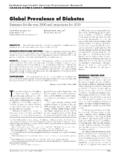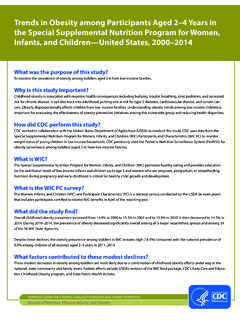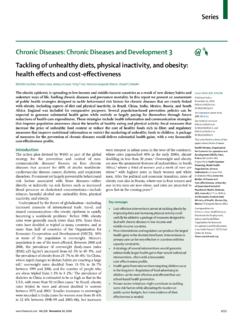Transcription of Weight Management Strategies for Adults and …
1 Weight Management Strategies for Adults and Youth with Behavioral Health Conditions January 2012 2 | Page 2012 Behavioral Health and Wellness Program, University of Colorado Prepared By: The Behavioral Health & Wellness Program School of Medicine University of Colorado Anschutz Medical Campus Karen Devine, , Chad Morris, , John Mahalik, , , Shawn Smith, , , Laura Martin, , Tamie DeHay, For additional Information please contact: Karen Devine, Health Services Manager University of Colorado Anschutz Medical Campus Department of Psychiatry Campus Box F478 1784 Racine Street Aurora, Colorado 80045 (p) (f)
2 3 | Page 2012 Behavioral Health and Wellness Program, University of Colorado Weight Management Strategies for Adults and Youth with Behavioral Health Conditions Table of Contents Introduction 4 Methodology 4 Literature Review 4 Introduction 4 Defining Excess Weight 5 Causes and Correlates of Excess Weight 6 Medical and Psychological Sequelae 9 Weight Control Strategies 10 Public Health Policy 13 Conclusion 15 References 16 4 | Page 2012 Behavioral Health and Wellness Program, University of Colorado I. INTRODUCTION Created by the Behavioral Health & Wellness Program, this report focuses on the Weight control issues seen in both Adults and youth with behavioral health conditions ( , persons with mental illnesses and/or addictions).
3 While our main aim was to report on Weight Management prevention and intervention Strategies for persons with behavioral health conditions, we found it necessary to also review the evidence base for the general population due to the limited study of Weight Management for this specific population. II. METHODOLOGY A literature review was conducted to: (1) Identify the factors associated with Weight control issues among Adults and youth with behavioral health disorders; (2) Summarize the existing evidence base for Weight control prevention and intervention Strategies with this population; (3) Report on evidence-based practices for the general population to supplement the limited study of persons with behavioral health conditions.
4 The review included literature published from January 1990 through December 2011. The search was conducted using Web of Science, PsychInfo, and the National Library of Medicine PubMed databases. Key search terms used in the search were: obesity, overweight, Weight Management interventions, mental illness and obesity, Weight maintenance, exercise, youth, Adults , BMI, obesity prevalence, poverty and obesity, food desert, barriers to Weight loss, prevention, policy related to Weight control, and public health interventions for Weight control.
5 The search included only articles in English. III. LITERATURE REVIEW Obesity in individuals from infancy to adulthood is a critical public health concern in the and worldwide. Approximately 300,000 deaths each year were associated with obesity and overweight ( DHHS, 2007). In the general population, the rates of obesity within the continue to grow at epidemic rates (CDC, 2011a). With more than 300 million individuals estimated to be obese worldwide, approximately 74% of Adults in the are either overweight or obese according to the National Health and Nutrition Survey (Ogden & Carroll, 2010; CDC, 2011a).
6 The total costs attributed to overweight and obesity in the general population amounted to $117 billion in 2000 alone ( DHHS, 2001). The prevalence and severity of obesity among children in the have likewise been steadily increasing over the past several decades, with the prevalence among 6-11 year olds doubling and among 12-17 year olds tripling between 1980 and 2000 (Levine, Ringham, Kalarchian, Wisniewski, & Marcus, 2001; National Center for Health Statistics, 2007). Presently, approximately 48% of adolescents ages 2-19 are 5 | Page 2012 Behavioral Health and Wellness Program, University of Colorado obese (CDC, 2011a).
7 The prevalence of overweight and obesity among adolescents is higher in the than in any other developed country (Speiser et al., 2005). In comparison to the general population, the problem of overweight and obesity is significantly more prevalent among persons with behavioral health conditions (Allison et al. 2009; NASMHPD, 2008). Among the 1 in 5 individuals in the having a diagnosable behavioral health disorder during the course of any given year, overweight and obesity represents an epidemic within an epidemic. (NASMHPD, 2008). Excess Weight is directly and indirectly linked to persons with behavioral health disorders living up to 25 years less than others (NASMHPD, 2008).
8 One prevalence study conducted on obesity and people with severe mental illnesses found 29% of men and 60% of women with severe mental illnesses were overweight or obese, compared to 18% of men and 28% of women in the general population (Daumit et al., 2003). Another study of 276 persons with mental illnesses found 22% to be overweight and 59% to be obese (Strassnig et al. 2003 as cited in NASMHPD, 2008). This health disparity is also found with youth. A study of children and adolescents who were obese found that 34% of the obese participants had psychiatric diagnoses, compared to the 20% of obese children and adolescents who had no such diagnoses (Janicke, Harman, Kelleher, & Zhang, 2008).
9 Defining Excess Weight In reviewing Weight issues and potential interventions, it is important to first define excess Weight . In Adults , there is general consensus that excess Weight is measured using standard categories of Body Mass Index (BMI). BMI is a direct calculation using height and Weight , and is a practical indicator for Adults of body fat. In the , Adults whose BMI measures kg/m are categorized as overweight, kg/m as mildly obese, kg/m as moderately obese, and > kg/m as extremely obese (NASMHPD, 2008). The measurement of excess Weight in children and adolescents is complex and there has not been consensus regarding standard definitions.
10 Adult standards are not applicable to children, who experience significant variability in BMI as they move through developmental stages. Measurement of BMI may actually underestimate the prevalence of obesity in young people (Bloomgarden, 2004). Several leading institutes in child and adolescent health, including the American Academy of Pediatrics, the National Heart, Lung, and Blood Institute, and the Center for Disease Control and Prevention (CDC), have adopted the standard of measuring overweight and obesity in children and adolescents based upon BMI percentiles. Sex-specific growth charts published by CDC provide norm-referenced age growth data for children and adolescents ages 2-19 years.






